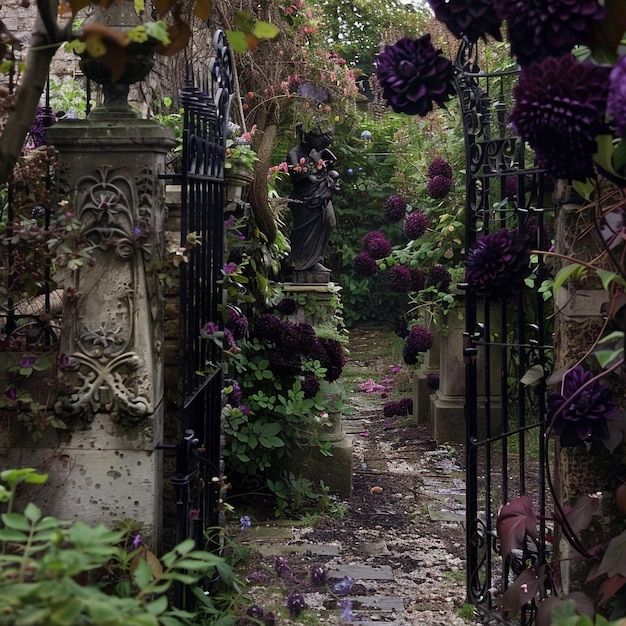For centuries, gardens have been metaphors of order — places where nature was tamed until it seemed obedient.
The gothic garden is born as a silent heresy: it rejects light, symmetry, and obedience.
It is a landscape of introspection and matter, where shadow is not threat but texture.
What distinguishes the gothic garden from any other is not its use of black flowers or exotic plants.
It is the conceptual gesture of refusing vegetal optimism.
Its beauty is not luminous — it is visual density.
Black, violet, and deep green act as language, not as color.
The Aesthetics of Darkness
While the French garden celebrates control and the English one the picturesque, the gothic cultivates contrast and interruption.
Between a moss-covered stone and a black flower lies an idea of time that accumulates instead of flowing.
Shadow-flowers — hellebores, belladonnas, black tulips, foxgloves — exist not to adorn but to disturb the gaze.
Dark color absorbs light, and with it, it also absorbs the observer’s haste.
A gothic garden does not wish to be photographed; it wishes to be breathed.
It is the anti-Instagram, the antithesis of the decorative.
Its plants seem to await a conversation, not a compliment.
The Species of Shadow
Each plant in a gothic garden possesses a different kind of presence — almost a mineral personality.
Black Tulip (Queen of Night) – the illusion of the absolute: it shines discreetly, as if the night had its own pigment.
Black Rose of Halfeti – grows only on certain banks of the Euphrates; less flower, more geological accident.
Helleborus niger, or Christmas Rose – blooms when the rest of the garden sleeps; paradox in vegetal form.
Atropa belladonna – dangerous yet disciplined. A lesson in the seduction of form.
Digitalis purpurea – vertical, almost architectural; it recalls the columns of a vegetal cathedral.
Tacca chantrieri – the bat flower: pure natural fiction.
Ophiopogon planiscapus ‘Nigrescens’ – an ornamental black grass, so contained it seems made of solid shadow.
Arum palaestinum – releases a metallic scent, as if exhaling oxidized memory.
None of these plants is conventionally “beautiful” — they are entities.
Together, they form a visual lexicon where error is aesthetic and poison is detail.
Architecture and Psychology of the Gothic Garden
The gothic garden is composed like a long, irregular sentence.
There is no central axis — only curves, shadows, textures.
Stone dominates more than metal; moss triumphs over lawn.
Everything seems about to collapse, yet it stands out of dignity.
It is an emotional architecture that rejects comfort.
Where the Renaissance seeks clarity, the gothic prefers nuance.
Its purpose is not to create beauty but to build atmosphere.
The visitor feels watched by leaves, branches, and shadows that appear to have their own intentions.
This kind of space does not console; it concentrates.
Its function is that of an empty library: to allow thought to manifest without witnesses.
From Physical Garden to Digital Garden
In contemporary visual culture, the gothic garden is reborn in virtual language.
3D renderings, artificial intelligence, biodesign — all reinvent botany as a metaphor for the human condition.
Digital art projects such as those of Refik Anadol, or photographic series inspired by Makoto Azuma’s dark flora, recreate this imaginary on a post-natural scale.
In the age of the backlit screen, the gothic garden becomes a gesture of deceleration.
It is not a refuge from technology but a way to think of technology as an ecosystem.
An invitation to observe — not to escape, but to understand what remains organic within the digital.
To build a gothic garden, physical or conceptual, is to accept that beauty does not always require redemption.
Some forms are born to be observed, not resolved.
Among dark petals and dense leaves lies a logic of the unfinished — and within it, its power.
In the end, the gothic garden is not about flowers.
It is about the gaze that lingers on what the rest of the world prefers to ignore.
